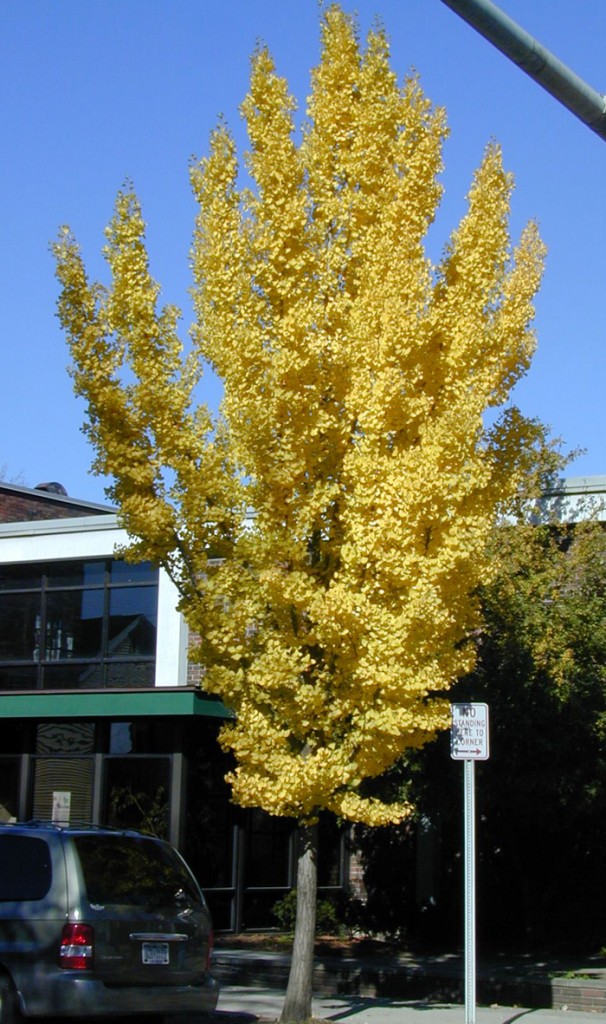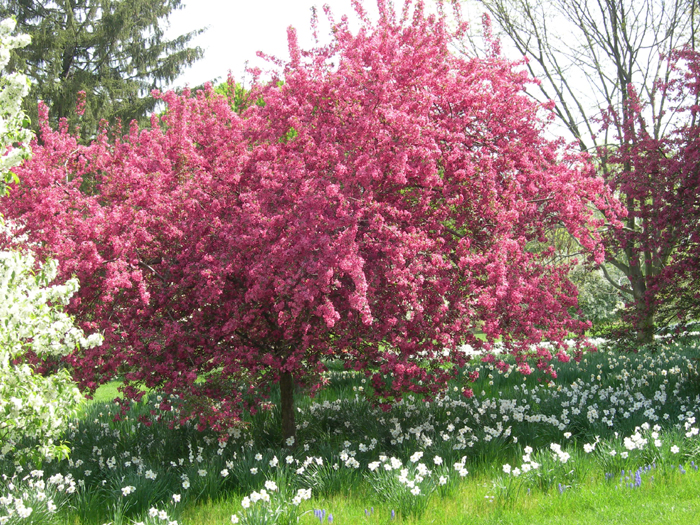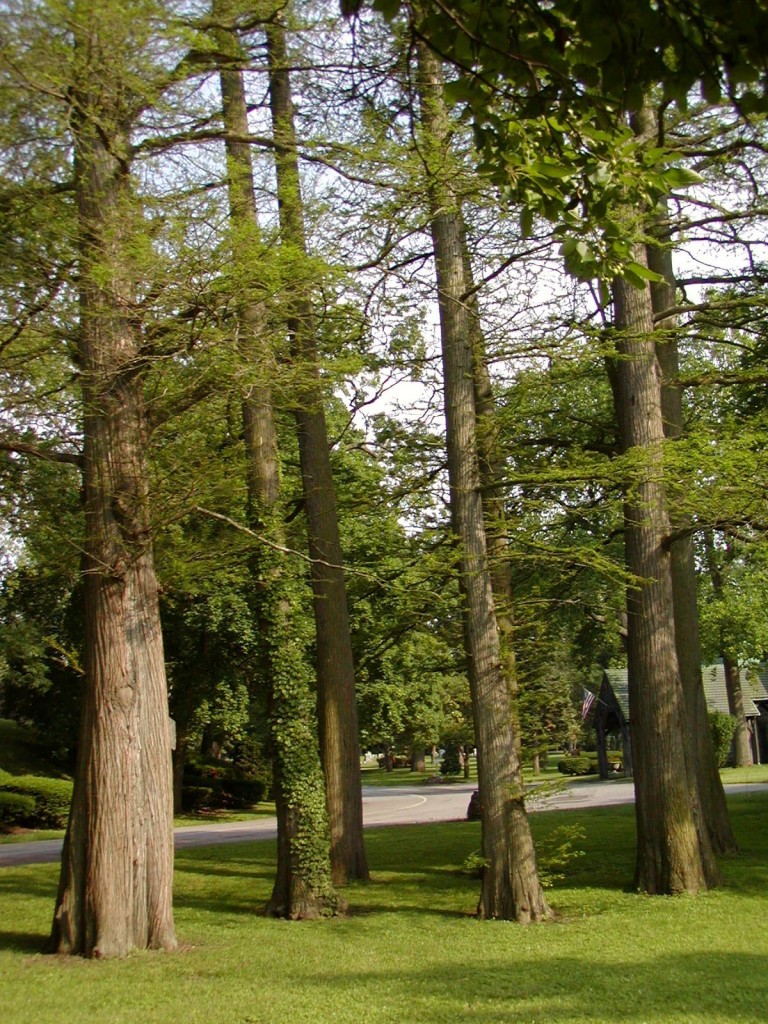“Urban Horticulture” sounds exotic and specialized, but it’s perhaps the most broadly applicable branch of horticulture. According to Cornell Urban Horticulture Institute Director Nina Bassuk, urban horticulture used to be called “human-impacted landscapes,” and among the landscapes in which we live, which ones are not greatly impacted by humans.
“Wherever people live,” Bassuk says, “the soil has been disrupted and probably significantly compacted, which reduces oxygen, nutrient, and water availability to tree roots. Frequently, housing construction debris has been buried on the site; buried cement blocks and cement sidewalks alike will drive the soil pH up. Heat is reflected off of buildings, paved surfaces, and cars, putting more water stress on plants. Salts used on paved surfaces run off into the soil, desiccating plant roots. Roots that are in the vicinity of pavement and structures often have limited soil volume to explore.” You get the idea: “urban” stresses, while particularly grievous along city streets, are present to varying degrees in our home landscapes.
One can use urban horticulture principles every day in residential situations to have greater success with plants. Site assessment and proper plant selection techniques are just as relevant to homeowners as they are to city foresters.
Getting Started
You’ll want to bookmark www.hort.cornell.edu/uhi. Go to the publication called “Recommended Urban Trees” (RUT), then go to “Site Assessment Checklist” and the adjacent document about how to complete it. The process of site assessment has you consider things like sun and shade exposure, USDA Hardiness Zone for your area, microclimates (for instance, the south side of your house versus the north), soil texture, pH, and drainage. This is a useful process for considering all types of plant material, not just the trees in RUT.
The checklist in RUT includes visual assessment of existing plants—both cultivated and wild. Noting what’s growing well—and what’s not—will give you insights into the site conditions. For instance, if rhododendrons, azaleas, and mountain laurel have lustrous dark green leaves and other signs of vigor, your soil is probably acidic to some degree. If your red maple or pin oak tree leaves are pale yellow, your soil may be alkaline. If you see girdling surface tree roots on more than one species of tree, there may be drainage and/or soil compaction problems.
This is a very sophisticated, thorough checklist. Will you fill out every box for every situation? No. But using the checklist gets you in the habit of thinking systematically about your site, and then you can engage in some informed plant-site matching. RUT is a great resource for any homeowner who has site challenges (i.e., every homeowner!) It includes profiles of more than 90 tough trees.
Sample Scenarios
This is a matching game. What are the site opportunities and restraints? What kind of tree (or shrub, or perennial) would you like to have? Which one will satiate your need for beauty but also perhaps fulfill practical functions like privacy/screening, habitat for wildlife, or shading your house? Do the site assessment results look favorable for your intended tree?
Scenario A
- You live in USDA Hardiness Zone 5a.
- Your soil is a desirable clay loam, easy to dig, and drains well, but you can tell by the kinds of plants growing wild there (or by doing a pH test) that you have a higher-than-average pH.
- You have a spot in full sun where you’d like to plant a shade tree that will make your back yard more hospitable in summer.
- There are no overhead wires or underground utilities in the vicinity.
- You would like something that is drought-tolerant, because the spot you have in mind is far enough from the house that you don’t realistically see yourself dragging hoses out there. (You’ll want to water it in the first few critical years, though, until it gets established—and in drought years).
- You want something with fabulous fall color.
A good match:
RUT has a small tree section and a medium-to-large tree section. For shade trees, we’re looking at the latter. RUT shows that most of the listed red maples and Freeman maples have beautiful fall color, but these maples are not especially drought tolerant. A katsura tree would be beautiful but again, can’t take things dry. A-ha! What about a ginkgo tree (a male cultivar, like ‘Autumn Gold’, with excellent golden yellow fall color)? It can take “prolonged periods of dry soil”, is sufficiently hardy (to Zone 4b), does fine with high pH … we have a winner!
Male cultivars of Ginkgo biloba with showy fall color offer both beauty and, once established, drought tolerance.
Scenario B
- You live in USDA Hardiness Zone 6a.
- You want a small tree in a pocket garden between your driveway and the front porch. It has to be a small tree because the bed is approximately 15 x 18 feet; there isn’t enough room above or below ground for a bigger tree.
- It’s the south side of the house, and due to the heat radiating from the house, driveway, and sidewalk, its gets hot and the bed dries out quickly, but it’s near the spigot, and you plan to water the tree.
- You would like showy flowers.
- There are no overhead wires or underground utilities in the vicinity.
- This garden bed gets salt runoff from the sidewalk.
A good match.
It’s challenging to find something small enough to fit this spot, but there is a whole page of compact crabapple cultivars in RUT that would do nicely, ones that are both disease resistant and have extra showy flowers. They can tolerate periods of dry soil and some salt runoff. Ding, ding, ding!
Compact, disease-resistant crabapple cultivars are equally useful to homeowners and city foresters.
Scenario C
- You live in USDA Hardiness Zone 6b.
- This part of your yard is flooded in the spring, but then gets quite dry in late summer. Ergo, you need something that can tolerate extremes of soil hydrology.
- There are no overhead wires or underground utilities in the vicinity. There is plenty of above- and below-ground space.
- Your soil is acidic to neutral (under 7.5).
- You like big trees, but you hate raking leaves.
A good match.
You have lots of room, so why not go for something that gets really tall (60 feet or more)? RUT shows that the majestic baldcypress (Taxodium distichum) is adapted to both seasonally wet and dry soils. It is hardy to Zone 5a or better. The leaflets are tiny and need no raking. We have a match!
Baldcypress (Taxodium distichum) tolerates extremes of wet and dry. Photo by Michelle Sutton.
Scenario D, Or, Not Every Site Can Support a Tree
Your soil is impenetrably hard to dig in and/or bedrock is close to the surface. You could remediate a discrete area of poor soil with compost and deep tillage, but it will be expensive to create enough hospitable soil volume for tree roots, which grow well beyond the canopy. Bassuk says, “There is one site problem that we cannot select for—and that is lack of rooting space.” Best not to plant a tree here.
Or, you’d love a weeping cherry but there is only 10 feet clearance between house and sidewalk (weeping cherry trees get much bigger than that over time). Or, you want an oak tree, but there are overhead wires in the vicinity. Find a place in your landscape where these trees will have adequate above- and below-ground room.
In terms of aerial room, RUT will tell you how big you can anticipate a tree getting. How much soil volume is adequate to support a tree of a given size? There is a terrific soil volume calculation guide on p. 20 of this UHI publication: www.hort.cornell.edu/uhi/outreach/pdfs/walk1.pdf.
More UHI Resources for Homeowners
The Cornell Woody Plants Database is another great tool for site-plant matching and includes shrubs as well as trees: http://woodyplants.cals.cornell.edu. Bassuk says a grant has been awarded to UHI that will enable the database to be upgraded soon, making it more user-friendly and field-friendly. The search function will be improved and a Cornell Woody Plants Database app for smartphones will be released.
Bassuk also wants readers to know about the community forestry resources page through the UHI site: www.hort.cornell.edu/commfor/resources/index.html. Here you can find pruning and transplanting guides, advice on how to avoid construction damage to trees, pest and disease problems, and much more practical information.
When we think about providing protective cover for slopes and other difficult sites, herbaceous groundcovers come to mind. Here is a really useful guide to deciduous woody groundcovers for such sites, borne from former graduate student Jamie Blackburn’s field testing of such underutilized plants in the city of Ithaca: www.hort.cornell.edu/uhi/outreach/pdfs/dwgc.pdf.
If you have a large enough property and are thinking about putting in a double row, or allée, of trees, instead of sinking all into a vulnerable monoculture, there is a way that you can plant a visually compatible diversity of trees; see:
www.hort.cornell.edu/uhi/outreach/pdfs/visually_compatible_trees.pdf.
Lastly, for site assessment purposes, to find out down to an “a” or “b” what your Hardiness Zone is, go to this USDA site for an interactive map:
http://planthardiness.ars.usda.gov/PHZMWeb/Images/150dpi/NY.jpg.
Photos Courtesy Urban Horticulture Institute, Cornell University, Ithaca NY, except where noted.
Views: 7










